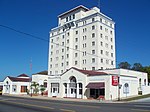Old Central Grammar School
1925 establishments in FloridaEdward Columbus Hosford buildingsFlorida school stubsHaines City, FloridaMediterranean Revival architecture in Florida ... and 4 more
National Register of Historic Places in Polk County, FloridaPolk County, Florida Registered Historic Place stubsSchool buildings completed in 1925Spanish Revival architecture in Florida

The Old Central Grammar School (also known as the Haines City Middle School Annex or Fellowship Dining-Ridge) is a historic school in Haines City, Florida. Built in 1925, it was designed by architect Edward Columbus Hosford in the Mediterranean Revival and Spanish Revival style. On March 17, 1994, it was added to the U.S. National Register of Historic Places. After being used for several years as a community theatre, the building is now part of Daniel Jenkins Academy of Technology, a middle school in the Polk County Public Schools district.
Excerpt from the Wikipedia article Old Central Grammar School (License: CC BY-SA 3.0, Authors, Images).Old Central Grammar School
South 8th Street,
Geographical coordinates (GPS) Address Nearby Places Show on map
Geographical coordinates (GPS)
| Latitude | Longitude |
|---|---|
| N 28.1034 ° | E -81.6246 ° |
Address
South 8th Street
33844
Florida, United States
Open on Google Maps









